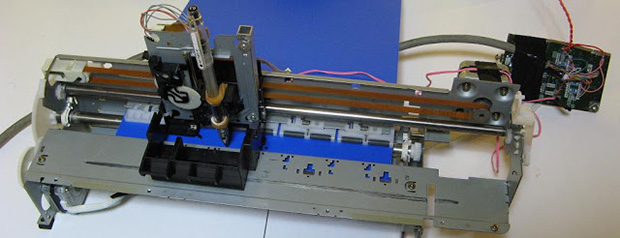
What do you do when you have an old printer, a portable CD player, and a handful of other electronics sitting around? Turn it into a plotter, of course.
The frame of the plotter was taken from a ye olde Epson printer, reusing the two stepper motors to move the paper along its length and width. The pen is attached to the laser head of a junked portable CD player. With this, it’s just three stepper motors that allow the Arduino control system to move the pen across the paper and put a few markings down.
The motors on the printer are, in the spirit of reuse, still connected to the printer’s driver board, with a few leads going directly from the Arduino to the parallel port interface. The motor in the CD player is another ordeal, with a single H-bridge controlling the lifting of the pen.
On the software side of things, a Processing sketch reads an SVG file and generates a list of coordinates along a path. The precision of the coordinates is set as a variable, but from the video of the plotter below, this plotter has at least as much resolution as the tip of the pen.














(I made this) It’s interesting that you chose to feature this version of the plotter rather than the pcb mill version which is on hackaday projects. I even gave you guys a nice picture of your logo made with it. Well, thanks for featuring this anyway.
You come across as a little ungrateful.
Both are nice hacks, you should be happy that one made it to the front page. That’s more than a lot of us can say about our projects.
Maybe you should submit a fail, it will appear! guaranteed!
Sorry it came across that way. I am always very happy when my projects are featured here. I just found it odd that this version was chosen. As always, HackaDay has my utmost gratitude. I’m not being sarcastic.
I couldn’t tell from the video, does the paper remain stationary (stationery- pun!) and the pen moves over it. Or does the paper move under the pen?
Oh, it pulls the paper through just like the olde printer did?
Yes, that’s right. one axis moves the paper, one axis moves the pen.
Could this easily be adapted to use a plotter blade for cutting vinyl?
“Here is the schematic taken out of the printer’s service manual”
Lucky! Manufacturers today are never this helpful…
Lots of printers will take HPGL (a vector format).. They plot it as raster, but it’s a neat way to print without having to render a bitmap first.
Still a pretty sweet toy. Mill addition is also interesting. (link for the lazy: http://projects.hackaday.com/project/283-PCB-mill-for-under-%2410 )
I once did something similar with the guts of a Cricut cutter. Since the cutter already had X/Y/Z hardware, controlled by an Atmega, this job was a lot easier. The only thing I had to do was to erase the existing firmware, reverse engineer the hardware, and write my own firmware. Here’s an old video:
http://www.youtube.com/watch?v=1UiKXeMWNb8
I’m curious – why is this different/better then a plain old inkjet printer?
It’s interesting because it’s a hack. Obviously, an inkjet printer is a superior tool for getting arbitrary shapes in ink on a piece of paper.
… That looks like a transport used in the Shigaraki CD transport, which are also found in JVC boom-boxes before being removed and turned into ‘Shigaclone’ transports.
Shigaclone, showing the transport: http://i.imgur.com/EHqP7fE.jpg
Very good project all the same. I have a few old B&W Canons in the basement for this very project, one day.
Oh, the memories of the then High end roland plotters, and the pens screctching at “high speed” over the paper. And the frustration when a pen got out of ink mid work and you needed to start again. :-)
This is the same principle, without the pen changing part.